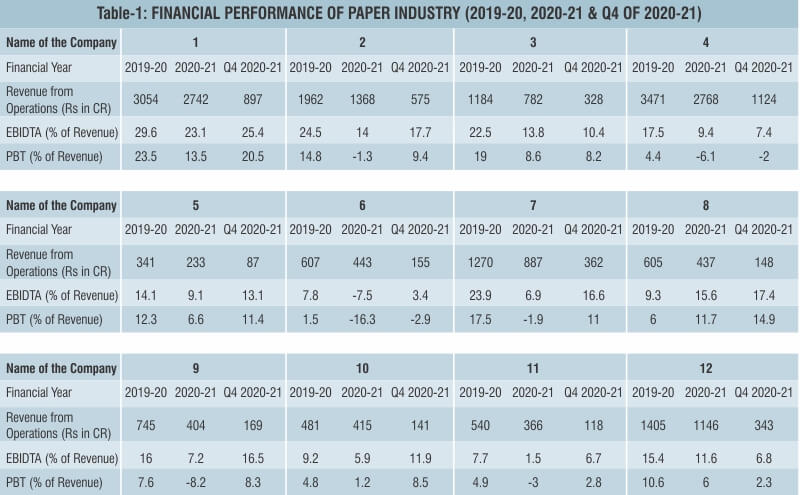This article is a part of Silver Linings to the Corona Cloud feature

Indian paper industry with a turnover of about INR 70,000 crores plays an important role in the manufacturing segment of the Indian economy. The paper industry like all other industries has also been affected adversely due to the outbreak of COVID-19. Indian paper industry is very fragmented and diverse in nature. There are small, medium and large size (from Indian perspective) mills — capacity wise, employing old to state-of-the-art technology. The fibrous raw material used for manufacturing paper include plantation wood from farm forestry programs, agri-residues like wheat straw and bagasse procured from farmers and waste paper sourced domestically as well as imported from other countries. The products manufactured are also diverse — kraft paper, newsprint, writing and printing papers, photocopier paper, unbleached and bleached varieties of packaging papers/boards, uncoated and coated boards, tissue paper and some tonnage of speciality papers.
Though all industry segments and individual mills have been affected adversely but being diverse in nature, it is but natural that different companies have been affected differently. This becomes evident later when financial performances of some companies will be presented.
Operations and Workforce Management
The mill operations of Indian paper industry were running smoothly up to 20th March 2021 when the decision about the country wide lockdown was taken by the government. During the lockdown, most of the mills stopped their operations completely during late March and April 2021. However, depending on the locations of the mill and the local conditions prevailing at that point of time, some mills started their operations partially from May 2021. Due to atmosphere of uncertainty and very little knowledge about COVID-19, there was confusion all over and the mills were considering different approaches to start their operations as such an unprecedented situation was never faced before. Some mills started running at a reduced capacity and were manufacturing for stock as the supply chain got disturbed and the demand had vanished all of a sudden. Q1 of 2020-21 was badly affected from all angles including operations, demand, prices, high stock levels and very low paper prices which were never seen before. Q1 sales were about 50 percent on a y-o-y basis with poor or negative margins.
Indian paper industry employs permanent workmen in its regular operations and most mills provide residential facilities to them. However, some contract workmen are engaged for operations which are not regular in nature. Although there is no authentic published numbers available to support this claim, but in general, the permanent workforce did not go anywhere as almost all mills paid wages without any deductions. The migration of contract workmen in organized sector was also minimal which did not affect operations of most of the mills. However, the impact of migrant workforce was felt in small and medium sized mills particularly those employing a higher share of their workforce on contract basis and not providing them residential facilities.
In the beginning of the pandemic, the industry manufacturing, selling and distributing essential items required for the pandemic were given permission to operate. Accordingly, the industry working in the area of health, hygiene, some food segments, e-commerce activities resumed operations because these sectors needed packaging material to pack and deliver their products. In July 2020, some easing in the lockdown restrictions started resulting in unlocking economy which showed its impact from late Q2 of 2020-21. This helped the industry particularly the packaging sector to start manufacturing operations and then slowly increasing their production. As a result, the sales in Q2 picked up which on average was about 70 percent of its pre-pandemic level but again with lower margins.
Further easing of restrictions and unlocking of the economy yielded better results in Q3 of 2020-21. The demand improved and the paper prices started increasing which further strengthened in Q4 of 2020-21. The sales in Q3 of 2020-21 was about 80 percent and about 90 percent in Q4 except for newsprint and writing and printing papers with prices almost close to pre-COVID level. These numbers above show a general trend and may differ from one segment to another and from one mill to another in the absence of any authentic published data except by some agencies, associations or institutions.
Supply Chain Management
Due to COVID-19 since March 2020, both inward and outward supply chains were disrupted. This had seriously affected the availability of all major inputs as stocks with the mills were on a normal level established over a period of time. Due to this disruption, any material which was in the pipeline did not reach the mills in time. However, it did not have much impact in Q1 of 2020-21 as the manufacturing activities were slow and there were stocks available just before the pandemic erupted and lockdown was announced. But as the production activities resumed towards the end of Q1, its impact was evident. Some inputs which are locally sourced with less lead time and stock for such inputs even though they are essential is not kept at the mills. Such inputs were not available in time due to restrictions of vehicle movement even within a state or at district level causing the stock out position and thus affecting the mill’s operations.
The outward disruption caused serious problems as all of a sudden; the material already manufactured and waiting for dispatches to the customers could not be moved. There were various kinds of restrictions within the country i.e. from one state to another, within the state, within the region and at district level. There was also not much clarity in the beginning which took time to resolve with the involvement of central government agencies which issued directions for the unrestricted movement of goods within the country. Even if the material somehow reached the customers, it could not be unloaded due to various reasons including non-availability of the workforce which is mainly contractual for these activities. This problem continued in Q2 as well, though to somewhat less extent, with some improvement from Q3 onwards and more improvement in Q4. The paper industry being alive to its responsibilities, made lot of efforts to restore the disrupted supply chains to make its products available to all the sectors.
Besides, there has been a major issue with the scarcity of shipping containers which are used for imports and exports of various inputs such as pulp, waste paper, chemicals and export of packaging paper, coated paper and boards and tissue paper including the more recent phenomena of kraft paper export to China. The availability of containers reduced with lot of uncertainty and the freight cost has increased to an unreasonably high level which has never been witnessed before.
Market Scenario
Some information has already been given earlier. In general, there was severe demand compression due to the lockdown in Q1 and Q2 of 2020-21 and closing of many educational institutions, commercial establishments including offices, downstream activities such as printers, publishers, converters and related services such as IT companies and service industries. Due to this reason, all segments of paper industry were adversely impacted, the worst being the writing and printing paper and newsprint segment. There was an improvement in Q3 and Q4 of FY 2020-21 but some segments like writing and printing continued to face the shortage of orders. Some companies tried to change the product mix to the extent it was possible in their respective operations but its impact was not much. Most companies except few performed quite well in the quarter January-March 2021 with close to normal production levels and price recovery close to the pre COVID level.
Profit Margin
The profitability of any paper industry segment or that of an individual company depends on many factors. It is difficult to make specific observations except that all mills in general performed badly in the first and second quarters of 2020-21 with some recovery witnessed in third quarter and more so in the fourth quarter. The published information about the financial performance of 12 companies is given in Table-1 without mentioning name of the company but the information is in public domain. These 12 companies represent the diversity of the nature of the industry in context of raw material usage, capacity, and product segment including speciality papers. One can compare the financial performance of 2019-20, 2020-21 and 4th quarter of 2021-22.
The reported financial results show that all the companies were impacted severely in FY 2020-21 as compared to FY 2019-20. The extent of loss in EBIDTA margin and PBT was different for different companies. The reasons were many such as the nature of fibrous raw material and their sourcing, type of papers produced, financial performance of the company before pandemic, product segment, flexibility in products switch over (limited for most mills), export potential and opportunities etc. For example, the companies manufacturing good quality tissue paper and packaging boards performed better than others due to export even though the margins were lower but the export orders ensured running the machines which helped in taking care of the fixed cost to some extent. The results of Q4 2020-21 (Tabulated here separately) were better as can be seen from Table-1. Most companies recovered fairly well in Q4 of FY 2021-22 and the Q1 of 2021-22 has also been encouraging.
There has been a substantial impact of the increase of most input prices on the cost of production. Some inputs during the pandemic have gone up beyond imagination. These include waste paper prices, imported chemicals, packaging materials, coal, domestic inputs due to increase in logistic and other cost etc. This has adversely affected the profit margins.

2. PBT is before considering any exeptional items
Expectations from the Government
All paper industry associations from time to time during the pandemic have been formally requesting the various government departments about their concern of the impact of COVID-19 and have given meaningful and practical suggestions to help and support the industry. Indian Paper Manufacturers Association (IPMA) had written to the Ministry of Commerce and Industry, Ministry of Labour, Department of Industrial Policy and Promotion, Finance Ministry in this regard. All such communications are in public domain which can be referred for details.
There always remains an issue of restricting indiscriminate imports of paper from China and ASEAN countries. Paper manufacturers in China and ASEAN countries enjoy access to cheap inputs and raw materials and also get incentives and subsidies. This does not allow the level playing field to Indian manufacturers in the domestic market. At times, there are surge in imports of paper from these countries which affect the domestic paper industry.
These are important but short term measures to help the industry. A more comprehensive presentation was given by Mr. A.S. Mehta in the capacity of Chairman of Development Council for Pulp Paper and Allied Industries (DCPPAI) on the subject of Ease of Doing Business (EoDB) on 18th August 2020 in the meeting convened by Department for Promotion of Industry and Internal Trade (DPIIT). This was later followed by giving specific suggestions priority-wise. Such suggestions are important and need government support to make the paper industry sustainable.
At the same time, the industry as a whole must take all necessary actions to make it more competitive in all respect and be environmentally sustainable. A number of paper companies have invested substantially in last 20 years in the technology upgradation, capacity expansion, energy and environmental management and more recently in CSR activities. This has to be done by all the companies in order to survive, sustain and grow. This pandemic has also given a message that the companies should have adequate reserves for the rainy days, not indulge in over leveraging themselves and have the financial capacity to take care of its financial commitments including payment of salary and wages to their employees during any lockdown period in future.
Future Outlook
As mentioned before, Q4 of FY 2020-21 showed a good recovery, especially in packaging and paperboard, and tissue segment as is evident from the financial results. This was expected to continue in subsequent quarters as well. However, after the second wave of pandemic, the scenario has somewhat changed from mid-April 2021 with drying up of orders in some segments. The financial results of Q1 of FY 2021-22, though not tabulated in Table-1, have been similar to Q4 of FY 2020-21, but the scenario may be somewhat different in Q2.
There has been apprehension about the possible third COVID wave with different predictions. This is causing anxiety with some fear psychosis in the business environment. The end users/dealers are not placing orders to build-up any stock at their level even for the coming festive season which used to see higher demand earlier. A lot will depend on the third COVID wave and its severity and how it impacts the people and the business. The government is doing its best to vaccinate as many people as possible which will be very helpful in fighting the virus. Everyone must follow the guidelines and COVID appropriate behavior to support the government efforts in controlling the disease. The data published by the government sources show the economic recovery in Q1 of the current financial year on expected lines as predicted last year and it is hoped that the trend will continue. With this economic recovery, the paper industry should also show better financial performance.
Coming to the specifics, the fibrous raw material scenario is not promising. The imported pulp prices have softened somewhat in last two months but owing to the higher freight cost, it is not certain if this downward trend in the landed pulp prices will continue. About 60 percent of paper production in India comes from the use of various grades of waste paper. The quality of domestic waste paper is poor and quantity is also limited. The imported waste paper in FY 2020-21 has seen an unprecedented increase in delivered price with uncertainty of availability most of the times. The higher prices are still continuing and there does not seem any possibility in near future to expect any substantial downward price correction. Some experts in the paper industry advocate the ban on the import of some grades of waste paper for the sake of environment and also think that this will force the stakeholders to increase recovery of domestic waste paper. This needs a careful assessment and consideration but the fact is that there are no concerted efforts at the country level to increase the recovery of domestic waste paper except few individual companies and organizations making their own efforts. It may be worthwhile to mention here that the waste paper recovery rate in EU during the pandemic has been almost the same as before the pandemic as there are strategies, EU policies, commitment of individual EU members, proper assessment, data sharing and monitoring at individual level and at common EU platform. In our country, we keep advising others to do something but without making any contribution from our side to improve the recovery rate of waste paper without any strategy either at any government agency or industry/institution level with a result that the waste paper recovery rate is at abysmally low level of 30 percent. Some individual companies/organizations have done pretty well but unless all stakeholders are involved, we shall continue to publish various reports but would not make any substantial progress in this area.
The prices of papermaking chemicals having seen the increasing trend in FY 2020-21 are at all time high now. The prices of imported chemicals are expected to see further increase owing to the higher freight cost. The domestically produced chemicals may also see further increase in prices as some of the ingredients used in manufacturing are imported. The current imported coal prices have almost doubled compared to the level one year ago and there is no possibility of prices coming down in near future. The sea freight has increased to an unprecedented high level resulting in substantial increase of the landed price of all inputs.
This substantial increase of all input prices will impact the cost of production adversely while paper prices are not likely to increase. It means the profitability of the paper industry in Q2 and Q3 is not expected to be the same as that of pre-pandemic level even if the overall recovery of the economy further improves.
Pudumjee Paper Products Ltd (PPPL) Pune
Pudumjee Paper Products Ltd (PPPL) stopped its operations completely w.e.f 21st March 2020. As the company manufactures speciality papers for pharma, hygiene and food segments, there was request by these end users to supply papers for their urgent requirements. Pudumjee is actually a speciality paper packaging solutions company. The company got permission to start its operations in the first week of May 2021 and after making our operations ready and employees prepared to observe the guidelines of regulatory authorities and COVID appropriate behavior, the operations were started on 10th May, 2020 with about 50 percent capacity. The production in Q1 was 38 percent, Q2 – 54 percent, Q3 -78 percent and Q4 – 87 percent with overall 64 percent production in 2020-21 as compared to 2019-20
In case of PPPL, there was no adverse impact of the workforce on operations as we paid full salary and wages to all our employees including most of the contract workmen during the lockdown period. Not a single employee including contract workmen was asked to leave the company during lockdown period. This generated lot of goodwill towards the company which has helped in improving the working environment.
It was hoped that being speciality paper manufacturing company producing products for companies that come under the category of essential services sector will not be hit as badly as other segments of the paper industry. But this has not been the case as many factors such as lockdown restrictions, non-availability of workforce in user industry, supply chain disruptions, payment issues from the customers impacted the company like any other paper segment. PPPL uses imported pulp for manufacturing its products and due to supply chain disruption, the availability became an issue particularly from Q2 onwards. Fortunately, there was sufficient pulp stock sourced at prices of around USD 500 available in the company and with the lower production in the first half of the year, it did not impact the operations. The pulp prices of speciality papers did not reduce as much as in other segments of the industry and even though the production in 2020-21 was only 64 percent of the production in 2019-20, the profitability could be maintained.
The current scenario in FY 2021-22 may not be as rosy as in previous year. The pulp prices had risen to the level of USD 800 for the hardwood and about USD 1100 for the softwood during later part of 2020-21 which have softened now. However, the future is uncertain due to high sea freight cost. The input prices of chemicals such as Titanium Dioxide and some other speciality chemicals have increased to an unprecedented level and with imported coal landed price around INR 10000/MT, the cost of production will only go up further. With paper prices not likely to increase in near future, the financial performance may not be as good as in FY 2020-21.




